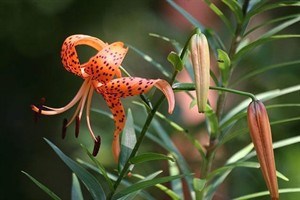
This July 24, 2006 image shows a Wild Tiger Lily in a wildflower garden near New Market, V.A. "Wild" tiger lilies are the ancestors of many hybrids seen in today's home flower beds. (AP Photo/Dean Fosdick)
June 19, 2012 - 2:29 PM
Wildflowers are an attractive choice for home gardeners who hope to attract wildlife with plants that are also low-maintenance, and drought- and disease-resistant.
Some wildflower varieties require more patience than others, however, requiring several seasons before they bloom.
"There are a couple of reasons why people get into wildflowers," said Russ Nicholson, senior agronomist for Pennington Seed Inc. in Madison, Ga. "One is that they're trying to reduce the size of the area being managed and know wildflowers are easy to grow. Or, two, they might be interested in birds and butterflies, and enjoy having feeders or houses in their gardens to connect with the wildflowers."
One person's wildflower, of course, may be another person's weed.
"Natives" are defined as plants that grew in North America before the Europeans arrived. "Weeds" are any plants growing where they're not wanted. And then there are "naturalized aliens," plants that have taken hold in certain areas but that should be avoided because they crowd out and contaminate native gene pools. That would include St. Anne's lace, chicory and ox-eyed daisies. Each appears on many state and federal noxious weed lists.
Shop around for wildflowers rather than seeking them out in the woods. The odds are against the latter surviving because they often require habitats different than those in your yard.
"It's illegal to pull them out of the ground on most public lands," said Mike Lizotte, managing partner for American Meadows, a gardening company in Williston, Vt. "That can draw a stiff fine."
Jerry Goodspeed, a Utah State University extension horticulturist, puts it another way: "Enjoy nature where nature is and go to a nursery if you want to grow wildflowers. More plant varieties are becoming available to homeowners each year."
Wildflower varieties are divided into meadow, woodland and wetland. All require some knowledge about where they grow best.
"Meadow varieties are the easiest to cultivate from seed," Lizotte said. "Some wildflowers need an exacting microclimate, especially the woodland types. It can take a white trillium from five to seven years to yield a flower from seed."
Many people new to wildflower gardening buy specialty seed blends that give good value for the money, Lizotte said. Wildflower seed mixtures generally include from a dozen to 30 varieties of annuals and perennials.
"Three or four years down the road, people start dialing in on the different species they really liked from the blends," Lizotte said.
Choose bare root plants, plugs or seedlings if you want your wildflower gardening to be fast and easy. Go with seeds if you have large areas to cover.
And mimic Mother Nature by planting in late fall or well into winter. "That will give them a chance to germinate earlier in the spring, before any leaves come out," Nicholson said. "It's getting pretty late to put something out there around Mother's Day that should be in the ground by February."
Always buy from a reputable source, Lizotte said. "Don't get fooled by packaging or price. Somewhere on the packaging, it will tell you what's in it. Ideally, you want 100 per cent pure seed free of any fill."
___
Online:
For more about the care and feeding of wildflowers, see this planting primer from American Meadows: http://www.americanmeadows.com/wildflower-seed-planting-instructions
You can contact Dean Fosdick at deanfosdick(at)netscape.net
News from © The Associated Press, 2012